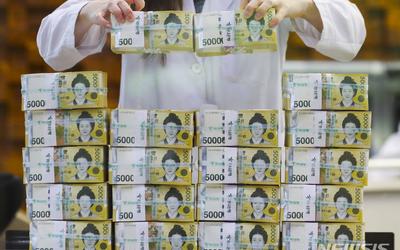Receiving balance 102 trillion… 1.6 trillion ↑ in one month
Credit balance 97 trillion… Conversion to increase only in 20 months
[서울=뉴시스]Reporter Lee Joo-hye = The savings bank deposit balance rose to the 100 trillion won range and increased for two consecutive months. It increased by more than 1.6 trillion won in one month. This can be interpreted as the effect of raising deposit interest rates. Due to the ‘balloon effect’ caused by the banking sector’s ‘loan tightening’, the amount of credit also turned to an increase.
According to the Bank of Korea’s economic statistics system announcement on the 16th, the mutual savings bank’s receipt balance was 102.5684 trillion won as of the end of September.
This is an increase of 1.6116 trillion won from 100.9568 trillion won in the previous month, continuing the increase for two consecutive months.
Deposits from savings banks fell below the 100 trillion won range at the end of July amid a downward trend, but increased by more than 1 trillion won in August, recovering to the 100 trillion won range again within a month.
Previously, savings banks raised deposit interest rates to recover when the deposit amount fell below 100 trillion won in 2 years and 8 months. Accordingly, deposits in the 4% range reappeared. According to the Korea Federation of Savings Banks, at the end of September, the average interest rate on term deposits (1 year) in savings banks rose to 3.70%, and the highest interest rate rose to 4.30%.
Based on the new handling amount in September compiled by the Bank of Korea, the mutual savings bank’s term deposit (1-year) interest rate is 3.73%, which is higher than that of deposit banks (3.39%), credit unions and Saemaeul Geumgo (3.55%), and mutual finance (3.38%). It was found that
However, recently, savings bank deposit interest rates have been falling again. This is due to the banking sector lowering deposit interest rates after the Bank of Korea lowered the base interest rate. The average interest rate for term deposits (12 months) of 79 savings banks nationwide announced by the Korea Federation of Savings Banks was 3.53% as of the previous day. It fell 0.17% points from a month ago. The highest interest rate is 3.80% per year.
It was found that not only the number of receipts but also the number of creditors increased. As of the end of September, the loan balance of savings banks was 97.893 trillion won, an increase of 496.4 billion won from the previous month (96.5929 trillion won), showing an increase for the first time in 20 months.
Savings bank loans collapsed in the 100 trillion won range in May this year, and in August fell to the lowest level in 2 years and 10 months since October 2021.
The increase in credit is interpreted as the result of savings banks resuming operations in the third quarter and an increase in the number of borrowers visiting second-tier financial institutions as the lending threshold for first-tier financial institutions increased. Previously, as the banking sector raised loan interest rates and strengthened conditions to manage the total amount of household loans, there were concerns about a ‘balloon effect’ in which loans from secondary financial institutions increased.
An official from a savings bank said, “As the end of the year approaches, the industry as a whole seems to be increasing reception and loan sales little by little.” He also added, “The loan balance has increased, but considering that it had previously decreased significantly, it is still not a large amount.”
He added, “Deposit interest rates are greatly influenced by commercial banks,” adding, “As the banking sector lowers deposit interest rates, savings banks are also lowering their interest rates to a level that maintains the interest rate gap.”
Meanwhile, as the ruling and opposition parties agreed to pass a revision to the Depositor Protection Act to increase the depositor protection limit from 50 million won to 100 million won, there is also speculation that a ‘money move’ toward savings banks may occur.
☞ Sympathetic media Newsis [email protected]
▶ Subscribe to Newsis on Naver
▶ K-Artprice reveals prices of famous works of art
The categories of this article follow the classification of media outlets.
The category an article belongs to is classified by the media company.
News organizations can classify an article into two or more categories.

